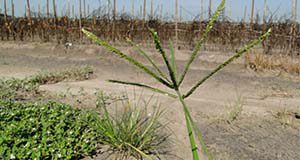This six-page fact sheet provides information about the biology and management of goosegrass, including preemergence and postemergence control options. Written by Shawn Steed, Christopher Marble, Nathan S. Boyd, Andrew MacRae, and Kiran Fnu and published by the Environmental Horticulture Department.
http://edis.ifas.ufl.edu/ep538
Tag: Poaceae (taxonomic family)
Biology, Control and Invasive Potential of Giant Reed (Arundo donax L.) in Florida

Arundo donax (L.), also known as giant reed, is a tall, fast-growing, bamboo-like grass that under ideal conditions can reach a height of up to 30 feet and a stem diameter up to 1.5 inches. Giant reed is invasive and difficult to control and has caused economic losses in California, Nevada, Utah, Arizona, New Mexico, and Texas. This species was introduced to Florida over 100 years ago and is currently naturalized in at least 26 of the 67 Florida counties. So far giant reed has not proved problematic in Florida, but recent permitting of its planting for bioenergy feed stock may increase the risk that it could naturalize into plant communities in Florida and other southeastern states and potentially cause economic losses as well as harm to native species and habitats. This 5-page fact sheet written by Pat Minogue and Seth Wright and published by the School of Forest Resources and Conservation describes the biology of this species and explains some strategies for its control.
edis.ifas.ufl.edu/fr396
SS AGR 301/AG307 Giant Reed (Arundo donax): Biology, Identification and Management
SS-AGR-301, a 4-page illustrated fact sheet by Kurt Vollmer, Curtis Rainbolt, and Jason Ferrell, describes this tall perennial grass that is commercially grown in the Mediterranean to make reeds for musical instruments, and which is a major invasive weed in Calfornia and Texas watersheds — its biology, identification and management. Includes references. Published by the UF Department of Agronomy, March 2008.
http://edis.ifas.ufl.edu/AG307
